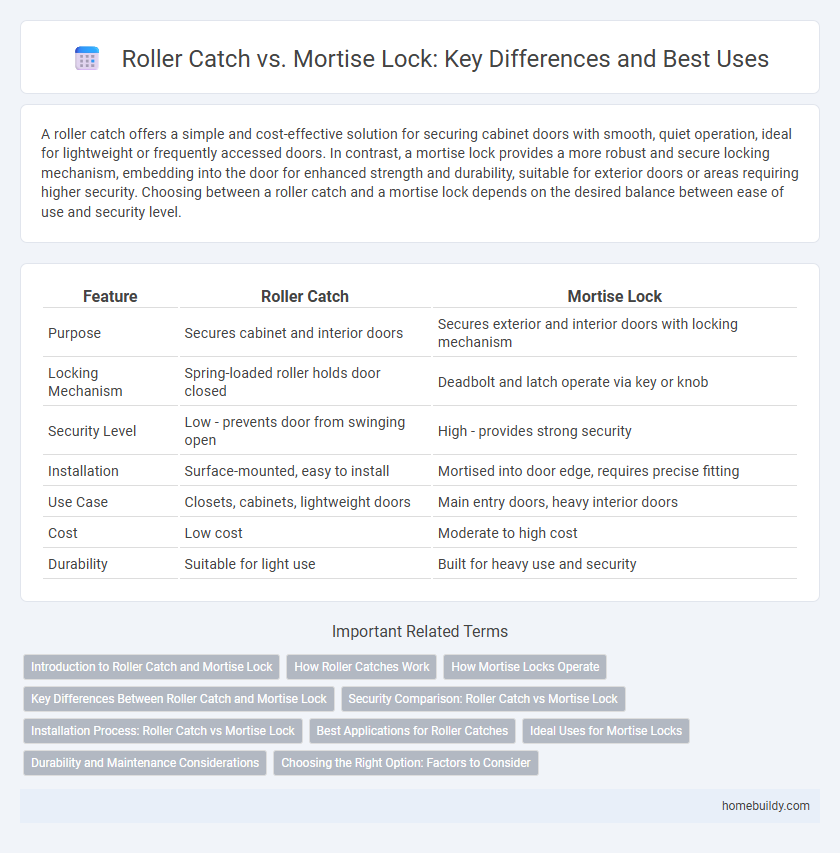A roller catch offers a simple and cost-effective solution for securing cabinet doors with smooth, quiet operation, ideal for lightweight or frequently accessed doors. In contrast, a mortise lock provides a more robust and secure locking mechanism, embedding into the door for enhanced strength and durability, suitable for exterior doors or areas requiring higher security. Choosing between a roller catch and a mortise lock depends on the desired balance between ease of use and security level.
Table of Comparison
| Feature | Roller Catch | Mortise Lock |
|---|---|---|
| Purpose | Secures cabinet and interior doors | Secures exterior and interior doors with locking mechanism |
| Locking Mechanism | Spring-loaded roller holds door closed | Deadbolt and latch operate via key or knob |
| Security Level | Low - prevents door from swinging open | High - provides strong security |
| Installation | Surface-mounted, easy to install | Mortised into door edge, requires precise fitting |
| Use Case | Closets, cabinets, lightweight doors | Main entry doors, heavy interior doors |
| Cost | Low cost | Moderate to high cost |
| Durability | Suitable for light use | Built for heavy use and security |
Introduction to Roller Catch and Mortise Lock
Roller catches provide a simple mechanism for securing cabinet doors using a spring-loaded roller that engages with a strike plate, offering ease of installation and smooth operation. Mortise locks are embedded within the door frame, delivering enhanced security through a deadbolt and latch system, commonly used for exterior doors. While roller catches prioritize convenience and light-duty applications, mortise locks are designed for robust security and durability in high-traffic or exterior settings.
How Roller Catches Work
Roller catches operate using a spring-loaded roller that compresses when the door is pushed closed and snaps into a strike plate to hold the door securely without a traditional lock mechanism. Unlike mortise locks, which require a recess cut into the door edge to house the lock body and latch, roller catches are surface-mounted, simplifying installation and reducing door modification. This mechanism provides a smooth, silent latching action ideal for cabinet doors and lightweight interior doors where security is not the primary concern.
How Mortise Locks Operate
Mortise locks operate by fitting into a pocket cut into the edge of a door, housing a locking mechanism controlled by a key or thumb turn. Unlike roller catches, which rely on spring-loaded rollers to hold a door closed without a lock, mortise locks provide enhanced security with a deadbolt or latch bolt that engages deeply into the door frame. This intricate mechanism makes mortise locks ideal for exterior doors requiring durable, reliable locking systems.
Key Differences Between Roller Catch and Mortise Lock
Roller catches operate using a spring-loaded roller to hold a door in place without a lock mechanism, offering simple latching suitable for lightweight or interior doors. Mortise locks involve a more complex installation within the door edge, providing secure locking with a key or thumb turn, ideal for exterior or high-security doors. The key differences center on security level, installation complexity, and intended use, with roller catches prioritizing ease and convenience, while mortise locks emphasize robust security.
Security Comparison: Roller Catch vs Mortise Lock
Mortise locks provide superior security compared to roller catches due to their robust metal construction and complex locking mechanism, which resists forced entry and lock picking more effectively. Roller catches primarily offer convenience for holding doors closed without a key-operated lock, making them suitable for interior or low-security applications but inadequate for external security needs. For secure access control, mortise locks remain the preferred choice because they integrate deadbolts and latch bolts, enhancing door security significantly beyond the capabilities of roller catches.
Installation Process: Roller Catch vs Mortise Lock
Roller catches offer a simpler installation process, requiring only surface mounting with screws, making them ideal for lightweight doors or cabinets. Mortise locks demand precise mortising of the door edge, involving chiseling or routing a recess to fit the lock body, which makes installation more complex and time-consuming. For quick, non-invasive setups, roller catches are preferred, while mortise locks require professional skills for secure, integrated installation.
Best Applications for Roller Catches
Roller catches are ideal for cabinet doors, closet doors, and lightweight interior doors where easy, tool-free entry is desired, providing a smooth and silent latching mechanism. Unlike mortise locks, which offer higher security for exterior doors, roller catches excel in low-security applications that require frequent access without a key. Their simple installation and minimal doorframe modification make roller catches especially suitable for furniture, interior cupboards, and other light-duty closures.
Ideal Uses for Mortise Locks
Mortise locks are ideal for commercial buildings and high-traffic areas due to their durability and enhanced security features compared to roller catches. They provide a more robust locking mechanism suitable for exterior doors and high-security applications where controlled access is critical. Mortise locks also accommodate a variety of door thicknesses and styles, making them versatile for both residential and institutional use.
Durability and Maintenance Considerations
Roller catches offer moderate durability with simple spring mechanisms that require minimal maintenance, making them suitable for light to medium usage in interior doors. Mortise locks provide superior durability due to their robust metal construction and complex locking components, ideal for heavy use and enhanced security. Maintenance for roller catches is generally easier and less frequent, while mortise locks may need periodic lubrication and adjustment to ensure long-term functionality.
Choosing the Right Option: Factors to Consider
When choosing between a roller catch and a mortise lock, consider factors such as security level, ease of installation, and door type. Roller catches offer simpler installation and are ideal for interior doors requiring light latching, while mortise locks provide higher security with complex installation suitable for exterior doors. Evaluate the door usage frequency, desired locking strength, and aesthetic preferences to determine the best option.
roller catch vs mortise lock Infographic

 homebuildy.com
homebuildy.com